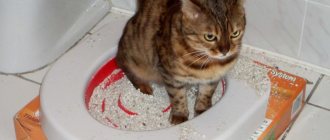What will you learn from the article?
- How to teach a kitten to sharpen its claws Step 1 Choose a scratching post
- Step 2 Restrict access
- Step 3 Choose a location
- Step 4 Increase Interest
When a kitten or an adult cat appears in the house, the owner becomes responsible for the new pet, its care and education. One of the main desires of the owner is to protect the furniture from damage.
- In this article we will tell you in detail how to train a cat to use a scratching post.
- Let's share some useful training tips.
- We'll show you how to quickly and easily teach a cat to sharpen its claws on a scratching post.
How to teach a kitten to sharpen its claws
The younger the kitten, the easier it is to train him. Kids quickly grasp everything and develop habits.
To ensure your kitten understands what you want from him, be consistent in your actions and be patient. Next, we will tell you step by step how to accustom a kitten to a scratching machine.
Step 1 Choose a scratching post
One important rule applies here - you choose not for yourself, but for your pet. There is no need to select this item to match the interior design of the apartment, choose models that visually appeal to you. If the kitten doesn't like the scratcher, the owners are doomed to failure.
- Give preference to tall models. The cat should be able to stretch and scratch as high as possible.
- If you bought a wall-mounted model of a scratcher, hang it so that while standing on its hind legs, the cat can fully extend its front legs over its head.
- Buy sustainable models. If the kitten feels that the scratching post is wobbly or shifting, he may become afraid and refuse to use it.
- Choose a texture that your pet will like. If the kitten likes to scratch the carpet, carpet options are suitable. If you're not sure what's right, try scratching posts with natural rope wrapped around a pole or corrugated cardboard models.
- Avoid models made of synthetic fibers and ropes, they create static electricity, which repels cats.
- Give your pet the opportunity to choose, purchase several accessories with different textures.
We recommend reading the article about which scratching post for cats to choose.
Step 2 Restrict access
Limit the animal's access to the areas it chooses to sharpen its claws.
- Cover upholstered furniture (sofas and armchairs) with covers, a heavy blanket or plastic wrap.
- Remove carpets or treat them with a citrus-scented spray; cats don’t like it.
- Wrap the scratched area with food foil or double-sided tape. Animals find it unpleasant to touch foil and sticky surfaces.
- Before leaving home, close rooms with upholstered furniture that the pet has chosen for sharpening its claws.
- Place the claw clipper directly in front of the object that the kitten likes to scratch.
Step 3 Choose a location
Choosing the location of the nail clipper is an important step in the training process. Scratching posts should be placed in areas suitable for cats. There is no need to put them in a corner or hide them in hard-to-reach places. This is convenient for owners, but cats will not like it. Place it where it is convenient for your cat to use it as a “territory marker.”
- Place it at the front door, under the window and in the place where the pet has chosen the place for sharpening its claws.
- If your cat likes to stretch and sharpen its claws after waking up, place a horizontal nail polisher where the cat likes to sleep.
- Watch the animal. If it sharpens its claws on vertical surfaces, place the nail clipper vertically. If your pet likes to sharpen its claws on carpets, place a horizontal model.
Place several scratching posts in different places. This will make it more likely that your cat won't touch your furniture or rugs.
Step 4 Increase Interest
The last step is to increase interest and draw attention to the scratching surface.
- To attract your cat to a new object, you can spray the scratching post with special training agents.
- You can increase the attractiveness of a new item for a cat with the help of valerian. A few drops of the product are enough to smear on the scratching post.
- Catnip has a similar effect, the smell of which drives kittens and adult cats crazy. Simply sprinkle dried mint on the base and top of your nail clipper.
- Engage with games and toys. Play with your kitten next to the scratching post. Decorate it with feathers or light balls for your pet to play with. So, during the game, the baby will understand that this object is convenient for sharpening his claws.
- Try placing the column sharpener on its side. This will make it easier for little kittens to get to know her. When they get used to it, place the post vertically.
- Praise your cat every time he uses this item for its intended purpose.
- Offer your pet's favorite treat when he places his paws on the nail sharpening surface. Give a treat every time the kitten sharpens its claws in the right place. Treats will help create a positive mood in the animal and the training process will go faster.
- You can attract attention by borrowing this cat accessory from your friends. The kitten will smell someone else's smell and will try to interrupt it by scratching the surface that retains the smell of another animal.
- Gently place your kitten's paws on the scratching surface and make a scratching motion. Be calm at this moment, speak kindly to the kitten.
The more often the kitten scratches the scratching post, leaving its smell, the more attractive this item will become for the pet.
Recommendations from experts
First, you need to wean your cat from sharpening furniture. There are special sprays for this.
And you should try to accustom him to the scratching post with the help of games.
Make a bow on a string, and when the cat is chasing it, put it on the scratching post - the cat should like it.
Evgenia Aleksandrova
https://forum.koschki.ru/index.php/topic/34-kak-priuchit-vzrosluiu-koshku-k-kogtetochke/
Encourage every time you see the scratching post being used: if you sharpen it, you get a treat, you praise it, you pet it. I tried to approach the sofa - they shushed me, slammed me with a newspaper, and sprayed me with a spray bottle. During the day, you can cover the armrests of the sofas with something like large towels/bedspreads so that it is inconvenient for him to touch them. In the meantime, someone is at home, watch, listen. Gradually, a reflex will form that the sofa is a nuisance, and the scratching post is a pleasure. Well, look for yourself: if the apartment is large, then it makes sense to install several scratching posts so that it is always at hand (under the paw, in the sense). Catnip and other baits will also play a role, but your behavior will matter more.
Mrss
https://www.u-mama.ru/forum/family/pets/714922/
Many cats do not like small scratching posts - it should be 65 - 70 centimeters high - otherwise the cat will not be able to stand on its hind legs and stretch out. When caught in the act of a crime, you take him to the scratching post and scratch it with his paws. Treat the scratching post with catnip and show it to the cat; many people react well to mint. Many people love corner scratching posts. When you leave, you can put a cover made of polyethylene film on the sofa. Or, leaving the cat alone, close the room - his bed is in the corridor, let him go to the kitchen to eat, to the toilet, and that’s it.
OAya
https://www.u-mama.ru/forum/family/pets/714922/
Features of training depending on the age of the kitten
1-1.5 months
At this age, patience and cat treats will be your helpers.
- Take the kitten's favorite treat and call him to the scratching post.
- Raise the treat over the kitten so that he reaches for it and puts his paws on the scratch pad.
- Praise him for this and give him a treat.
- Stroke and talk affectionately.
- Repeat these steps until the baby learns to sharpen his claws in the right place.
2-2.5 months
Grown-up kittens are trained in the form of a game. They attract attention with the help of toys and show how to sharpen their claws. The owner’s main goal is to show the pet that this new item can be fun to play with. Positive results are rewarded with praise and treats.
4-5 months
As kittens mature, they develop their own preferences and form habits. The main efforts of the owner of such a kitten should be aimed at combating scratching of furniture and carpets. Inappropriate places for scratching should be made unattractive and repulsive. And attract attention to the scratching post with sprays or other scents that cats like (catnip, valerian).
Video
How to train an adult cat to use a nail sharpener
If you need to train an adult cat that picks wallpaper, furniture and carpets, you will have to be patient. Adult animals are self-sufficient. They will not tolerate you picking up their paws and using them to scratch the surface to sharpen their claws. This will scare the pet away and he will avoid the scratching post. This training method only works with small kittens.
What can help with training?
- You can try treating the surface of the nail clipper with sprays with an attractive scent.
- Borrow a scratching post from your neighbors. An adult animal will try to cover up someone else's smell with its own.
- To attract your cat's attention, sprinkle dried valerian or catnip onto a scratching post and rub the herb into the scratching surface.
- Offer your cat a large size scratcher; small models can be ignored by adult pets without showing interest in them.
- Cover the areas your cat chooses to scratch with bubble wrap. The sound of popping bubbles scares away animals.
- Every time your pet shows interest in the scratcher, praise him and reward him with a treat.
Video
What measures should not be used when training a cat?
The main thing in training is an affectionate attitude towards your friend.
In order for the cat to use the scratching post for its intended purpose, you must first of all be patient and not be too persistent in training. Don't demand instant results from your animal. Your pet needs time to get used to the accessory. Excessive pressure on the animal will only slow down the training.
You should not splash water on your cat while he is scratching things with his claws. The pet will be scared and afraid to do this trick again. The tailed animal will experience stress and may even become more aggressive, so this method can hardly be considered humane.
Don't yell at the animal. Do not grab the cat by the paws or tail or force it to scratch the product. She can link owners' aggression directly to the scratching post. Then the pet will be afraid of the claw hammer. In this case, it is necessary to start training again. The scratching post will have to be replaced with a new one, which is not associated with negative memories of the animal.
It is worth approaching responsibly when training a cat to use a scratching post. The pet friend does not understand human language and often scratches things without malicious intent. Therefore, you need to be affectionate towards your pet. In addition to accustoming the animal to the accessory, do not forget to constantly care for its claws and trim them in a timely manner.
How to accustom a cat to a new scratching post
If you bought a new scratching post, but your cat ignores it and doesn’t understand what this item is for, use our tips:
- Spray the new item with catnip solution or a special training product.
- Pet your pet with a piece of fabric, tie a scarf with a scent to a post, this will increase interest in the purchase. Cats are not afraid of things with their own scent.
- Pet someone else's cat with a handkerchief and attach the handkerchief to the panel. Your pet will not tolerate someone else's smell; it will try to get rid of it by tearing off the handkerchief with its claws.
- If the pet does not show interest in the new product, try moving it to another place. Place it under the window, where the cat is used to watching what is happening on the street and spying on birds. Excitement encourages scratching.
What should you pay attention to when choosing a scratching post?
When choosing a scratching post, you need to consider several factors. Firstly, it must be durable. If the product is vertical, it should be tall. The cat will ignore the short sharpener.
Secondly, the sharpener should not swing or move. The stability of the product is ensured by a wide, heavy base. If the scratching post moves, the cat may get scared. In addition, such a sharpener may fall on the cat and he will no longer dare to approach it.
Your cat should like the texture of the sharpener. You should not buy an item with plastic elements or artificial winding. These materials are static and can shock your pet.
Each tailed animal should have its own sharpener. If there is only one, pets may mark it over and over again to remove the foreign scent. Because of this, it will spoil in a few weeks.
Every furry friend should have their own favorite scratching post.
Tips for training a scratching post
10 effective tips that will lead you to success:
- Offer your cat different models (by location, texture). This way you will find one that the animal likes.
- Move the scratching post around until you find a spot that interests your cat the most.
- Patiently repeat the attempts, bringing the cat to the scratcher several times a day. Try to catch the moment when the animal just woke up. After sleep, most cats stretch and scratch with their claws.
- Purchase several models of different textures and orientations (horizontal, vertical, angular, oblique). The cat must have a choice.
- If a cat scratches its claws in the wrong place, you need to strictly tell it “no”, teaching it to the command, and take the pet to a place where it can scratch. Screaming and being an animal is unacceptable!
- Choose a model of the correct height. The cat must be able to stretch its spine - this is one of the reasons for scratching. Models that are too low are not suitable for this.
- Start training to use a nail clipper from a very early age.
- Make sure the fastening is secure. Buy models with a stable base or attach it to the floor. Cats are afraid of scratching posts that swing under the weight of the animal.
- For each animal in the house there should be at least two places for sharpening claws.
- Treat all scratchable surfaces with synthetic pheromones.
Common types
In addition, teaching a cat to scratch a scratching post will be easier if you choose the right type of scratching post. When making this choice, you should take into account the habits and temperament of your pet.
So, what types of scratching posts are there? There are 7 types of them :
- Column. It will benefit not only the pet’s claws, but also its skeleton and muscles, since the mustachioed one will be able to climb on it and frolic very happily.
- House. In addition to the fact that the cat will be able to sharpen its claws, it will also acquire a secluded place for itself. An excellent option would be to choose a house with parameters of 30x30 cm. You can train a cat to a house with a scratching post in the same ways as to a regular one.
- Playground. It is a combination of a labyrinth and a variety of stairs, which will be excellent entertainment for the animal.
- Cardboard scratching post. Its disadvantage is its fragility, since it wears out quickly. A plus is that this scratching post is made of environmentally friendly material.
- Jugite is an excellent material for sharpening claws.
- Sisal is more stable in use than the above options.
- Wooden is the most durable of all types.
© shutterstock
Tools for accustoming to a scratching post
The pet industry offers veterinary products for accustoming dogs to scratching posts. Use them to speed up learning and increase your animal's interest in the subject.
The best training tools:
- Spray Ms.Kiss. Price: 170 – 180 rub.
- Mr. Fresh Expert. Spray for scratching post. Price: 230 – 280 rub.
- Spray STOP problem. Price: 115 – 180 rub.
- Apicenna smart spray. Price: 250 – 290 rub.
- Comfort clawed trainer. Spray. Price: 170 – 180 rub.
- Matatabi, Japan Premium Pet. Powder to attract a cat's attention. Price: 200 – 240 rub.
- Catty Home, Beaphar. Drops for treating scratching posts. Price: 440 – 600 rub.
- Catnip, Beeztees. Dried catnip. Price: 150 – 210 rub.











